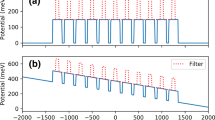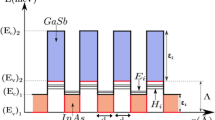Abstract
The biggest challenge in 8–12 micron infrared detection is low photon energy and unavoidable thermal noise. Thermo-sensitive photoelectric detection attracts much attention operating at room temperature. This material’s temperature coefficient of resistance (TCR) has become the most critical parameter for the devices. Traditional vanadium oxide and amorphous silicon materials have flaws. However, silicon-based quantum well materials show much promise as a replacement. The research focuses on the quantum well material’s physical model to determine the link between structural factors and TCR. According to the results, the energy level difference can be used as a goal analytical parameter to evaluate the TCR of thin film materials. The energy bands and carrier concentration distributions in equilibrium and non-equilibrium states were discovered via analysis and simulations. The quantum well materials were epitaxial growth, and the pixels used for electric performance tests were fabricated. As the experiments, the TCR of the material around the room temperature is about \(-2.92\)%/K.










Similar content being viewed by others
References
E. Smith et al., HgCdTe focal plane arrays for dual-color mid- and long-wavelength infrared detection. J. Electron. Materials. 33(6), 509–516 (2004)
P.J. Carrington, V.A. Solov’ev, Q. Zhuang et al., Room temperature midinfrared electroluminescence from InSb/InAs quantum dot light emitting diodes. Appl. Phys. Lett. 93(9), 91101–91101 (2008)
Y. Zhu et al., Mid-wave/long-wave dual-color infrared quantum cascade detector enhanced by antenna-coupled microcavity. Opt. Express. 29(23), 37327–37335 (2021)
K. L. Wang, R. P. G. Karunasiri, J. S. Park, Intersubband absorption in Si1-xGex/Si and \(\delta \)-dope Si multiple quantum wells. Surface Sci. (1992)
D. Marris-Morini et al., Germanium-based integrated photonics from near-to mid-infrared applications. Nanophotonics. 7(11), 1781–1793 (2018)
L. Höglund et al., Energy level scheme of InAs/InxGa1-xAs/GaAs quantum-dots-in-a-well infrared photodetector structures. Physical review. B, Condensed matter. vol. 82, no. 3, (2010)
F. Forsberg et al., CMOS-integrated Si/SiGe quantum-well infrared microbolometer focal plane arrays manufactured with very large-scale heterogeneous 3-D integration. IEEE J. Selected Topics Quantum Electron. 21(4), 30–40 (2014)
Q. Cheng, S. Paradis, T. Bui, M. Almasri, Design of dual-band uncooled infrared microbolometer. IEEE Sens. J. 11(1), 167–175 (2010)
Z. Guo et al., Performance analysis of microcantilever arrays for optical readout uncooled infrared imaging. Sens. Actuat. A Phys. 137(1), 13–19 (2007)
M. A. Hu Be R et al., Ultrafast Mid-Infrared Nanoscopy of Strained Vanadium Dioxide Nanobeams. Nano Letters. vol. 16, no. 2, p. 1421, (2016)
J. Schneider et al., Infrared spectra and electron spin resonance of vanadium deep level impurities in silicon carbide. Appl. Phys. Lett. 56(12), 1184–1186 (1990)
J.L. Tissot, P. Robert, A. Durand, S. Tinnes, E. Bercier, A. Crastes, Status of uncooled infrared detector technology at ULIS. France. Defence Sci. J. 63(6), 545–549 (2013)
M. Moeen, M. Kolahdouz, A. Salemi, A. Abedin, M. Östling, H. Radamson, Enhanced device designs for Si-based infrared detectors. Appl. Phys. Lett. (2015)
S. Bozzo et al., Chemical vapor deposition of silicon-germanium heterostructures. J. Crystal Growth. 216(1/4), 171–184 (2000)
M. Kolahdouz, M. ÖStling, H. H. Radamson, High performance infra-red detectors based on Si/SiGe multilayers quantum structure. Materials Science & Engineering B. vol. 177, no. 17, pp. 1563-1566, (2012)
F. Niklaus et al., Wafer bonding with nano-imprint resists as sacrificial adhesive for fabrication of silicon-on-integrated-circuit (SOIC) wafers in 3D integration of MEMS and ICs. Sens. Actuat. A Phys. 154(1), 180–186 (2009)
Acknowledgements
This research was funded by National Natural Science Foundation (61805121, 62001223, and 61971466), Jiangsu Natural Science Foundation (BK20170850, BK20190471), China.
Author information
Authors and Affiliations
Corresponding author
Rights and permissions
About this article
Cite this article
Jiang, B., Su, Y. A physical model of multi-quantum well material applied in the mid-infrared detector. Eur. Phys. J. Spec. Top. 231, 659–664 (2022). https://doi.org/10.1140/epjs/s11734-022-00461-5
Received:
Accepted:
Published:
Issue Date:
DOI: https://doi.org/10.1140/epjs/s11734-022-00461-5




